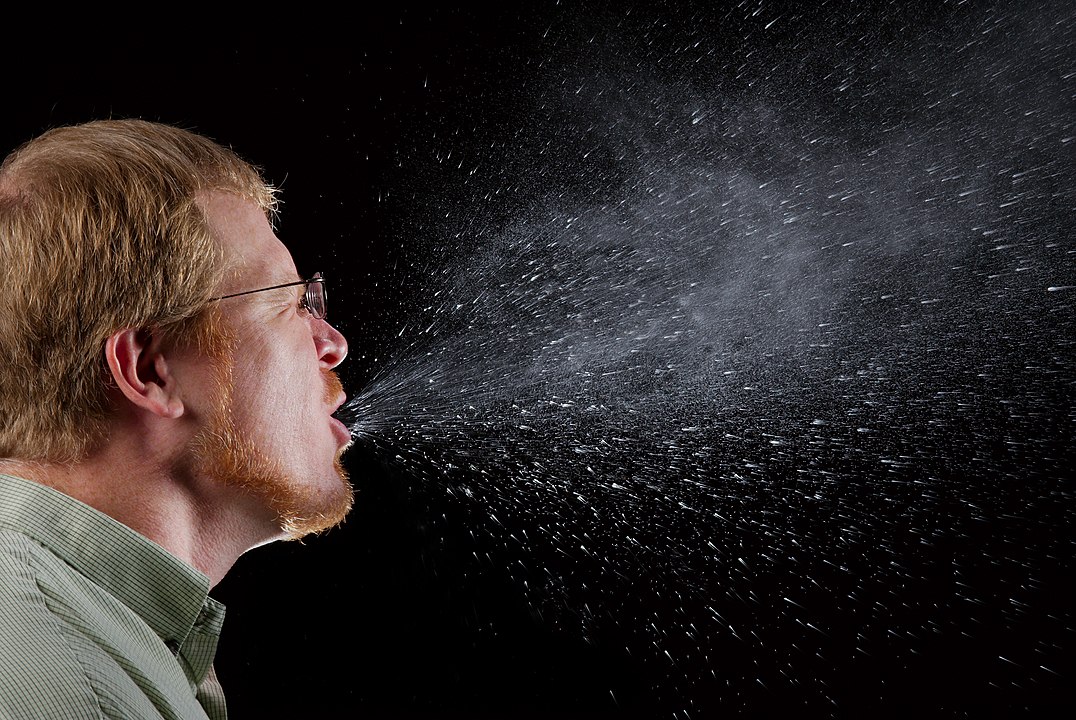During coughing or sneezing, or even during talking, tiny particles of water and mucus are expelled from our mouth and nose. These are droplets. Respiratory pathogens like some viruses and bacteria can hitch a ride on these droplets and transmit from person to person.
What are droplets
Droplets are tiny particles of water and mucus expelled from our respiratory tract. Depending on the size, these particles are divided into two categories — droplets and droplet nucleicowling2013.
The particles larger than 5 μm are called droplets. As they are larger, they settle down quickly after being expelled. Usually they don't travel beyond 1 to 2 meters.
Droplet nuclei on the other hand are smaller than 5 μm. Their smaller size allows them to travel longer distances. But they also dry up easily. They are also called aerosols.
Droplet generation
Droplets are produced during coughing and sneezing. They are generated even during regular speech. As expected, higher voice generates higher amount of dropletsanfinrud2020.
Certain procedures are known to produce a higher amount of droplets. Such procedures include nebulisation, intubation etc.

Role of droplet in infection transmission
A person infected with respiratory pathogens may expel droplets containing the infecting pathogen present in his/her respiratory tract. If such droplets are inhaled by a healthy person the pathogen will find its way into the respiratory tract of the healthy person and cause infection. This is one of the reasons why these pathogens can spread so rapidly.
Some pathogens retain their infectivity even after the droplets have settled down on the surface. If hands contaminated with such deposited material touches a healthy persons face, the pathogen maybe successful in infecting that person.
Generally the infectivity of droplets depend on the environmental conditions. Temperature directly affects the survivability of the pathogen whereas the humidity of the air determines the evaporation of the dropletmarr2019.
Infections transmitting through droplets
A number of viral as well as bacterial and fungal infections may transmit through dropletsfernstrom2013.
Virus
Viruses transmitting through droplets include—
- Corona virus
- Influenza virus
- Adenovirus
- Rhinovirus
- Measles
- Respiratory Syncitial Virus
Etc.
Bacteria
Droplet may help in spreading bacteria like—
- Streptococcus
- Staphylococcus
- Mycoplasma
- Meningococcus
- Pertussis
- Tuberculosis
Etc.
Fungus
Some fungus may spread through droplets as well—
- Aspergillus
- Cryptococcus
- Histoplasma
- Pneumocystis
- Zygomycetes
- Mucor
Etc.
Droplet precautions
A number of measures can be taken to prevent transmission of infection via droplets, which includes—
Respiratory hygiene
Covering the face with handkerchief or elbow prevents dispersal of droplets. Wearing a mask also works the same way. During an outbreak it may be necessary to maintain safe distancing between individuals.
Hand washing
Since surface deposited droplets may contaminate hands, it may also be necessary to wash hands properly to avoid being infected.
Isolation
A person suspected to be infected with a highly infectious respiratory pathogen may be needed to be kept in isolation till cured in order to prevent the infection from spreading to others.
Personal Protective Equipment
The persons involved in the care of a highly infectious patient need Personal Protective Equipment to avoid contracting the disease from the patient.
- Cowling BJ, Ip DK, Fang VJ, Suntarattiwong P, Olsen SJ, Levy J, Uyeki TM, Leung GM, Malik Peiris JS, Chotpitayasunondh T, Nishiura H, Mark Simmerman J. Aerosol transmission is an important mode of influenza A virus spread. Nat Commun. 2013;4:1935. https://doi.org/10.1038/ncomms2922. PMID: 23736803; PMCID: PMC3682679
- Anfinrud P, Stadnytskyi V, Bax CE, Bax A. Visualizing Speech-Generated Oral Fluid Droplets with Laser Light Scattering. N Engl J Med. 2020 Apr 15:NEJMc2007800. https://doi.org/10.1056/NEJMc2007800. Epub ahead of print. PMID: 32294341; PMCID: PMC7179962
- Fernstrom A, Goldblatt M. Aerobiology and its role in the transmission of infectious diseases. J Pathog. 2013;2013:493960. https://doi.org/10.1155/2013/493960. Epub 2013 Jan 13. PMID: 23365758; PMCID: PMC3556854
- Marr LC, Tang JW, Van Mullekom J, Lakdawala SS. Mechanistic insights into the effect of humidity on airborne influenza virus survival, transmission and incidence. J R Soc Interface. 2019 Jan 31;16(150):20180298. https://doi.org/10.1098/rsif.2018.0298. PMID: 30958176; PMCID: PMC6364647
 RSS Feed
RSS Feed